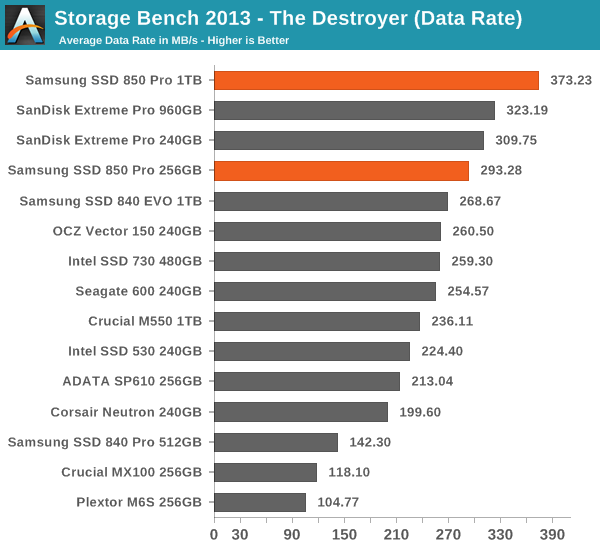Samsung SSD 850 Pro (128GB, 256GB & 1TB) Review: Enter the 3D Era
by Kristian Vättö on July 1, 2014 10:00 AM ESTAnandTech Storage Bench 2013
Our Storage Bench 2013 focuses on worst-case multitasking and IO consistency. Similar to our earlier Storage Benches, the test is still application trace based - we record all IO requests made to a test system and play them back on the drive we are testing and run statistical analysis on the drive's responses. There are 49.8 million IO operations in total with 1583.0GB of reads and 875.6GB of writes. I'm not including the full description of the test for better readability, so make sure to read our Storage Bench 2013 introduction for the full details.
| AnandTech Storage Bench 2013 - The Destroyer | ||
| Workload | Description | Applications Used |
| Photo Sync/Editing | Import images, edit, export | Adobe Photoshop CS6, Adobe Lightroom 4, Dropbox |
| Gaming | Download/install games, play games | Steam, Deus Ex, Skyrim, Starcraft 2, BioShock Infinite |
| Virtualization | Run/manage VM, use general apps inside VM | VirtualBox |
| General Productivity | Browse the web, manage local email, copy files, encrypt/decrypt files, backup system, download content, virus/malware scan | Chrome, IE10, Outlook, Windows 8, AxCrypt, uTorrent, AdAware |
| Video Playback | Copy and watch movies | Windows 8 |
| Application Development | Compile projects, check out code, download code samples | Visual Studio 2012 |
We are reporting two primary metrics with the Destroyer: average data rate in MB/s and average service time in microseconds. The former gives you an idea of the throughput of the drive during the time that it was running the test workload. This can be a very good indication of overall performance. What average data rate doesn't do a good job of is taking into account response time of very bursty (read: high queue depth) IO. By reporting average service time we heavily weigh latency for queued IOs. You'll note that this is a metric we have been reporting in our enterprise benchmarks for a while now. With the client tests maturing, the time was right for a little convergence.

Thanks to the excellent IO consistency, the 850 Pro dominates our 2013 Storage Bench. At the 1TB capacity point, the 850 Pro is over 15% faster than any drive when looking at the average data rate. That is huge because the 850 Pro has less over-provisioning than most of today's high-end drives and the 2013 Storage Bench tends to reward drives that have more over-provisioning because it essentially pushes drives to steady-state. The 256GB model does not do as well as the 1TB one but it is still one of the fastest drives in its class. I wonder if the lesser amount of over-provisioning is the reason or perhaps the Extreme Pro is just so well optimized for mixed workloads.











160 Comments
View All Comments
extide - Tuesday, July 1, 2014 - link
Well, kinda, I mean, some implementations come from the IOH instead of the CPU. I have heard rumors that future versions of Intel Desktop CPU's will have 20-24 PCIE lanes on them instead of 16. That would be perfect for storage!smithrd3512 - Tuesday, July 1, 2014 - link
Gotta love that warranty. 10 years on the drive. Might be worth the extra cost just for that alone.rahuldesai1987 - Tuesday, July 1, 2014 - link
"That is very aggressive because it essentially implies that the die capacity will double every year (256Gbit next year, 512Gbit in 2016 and finally 1Tbit in 2017)" - Does this mean a 8TB drive at $600 in 2017 ($75 per TB). Good bye hard drives by then :). What about a 850/850 Evo version?DarkXale - Tuesday, July 1, 2014 - link
It certainly does imply 8TB SSDs by 2017. By that point such a SSD will likely have a higher capacity than HDDs of that time.Of course, price will be very significantly in favour of the HDD still; but if money is no object you could do bulk storage in a portable device if you wanted to.
CalaverasGrande - Tuesday, July 1, 2014 - link
This may become an exhibit in some future dispute between Samsung and Apple. Those prices are easily Apple territory.extide - Tuesday, July 1, 2014 - link
Ehh, those prices were par for the course 18-24+ months ago!toyotabedzrock - Tuesday, July 1, 2014 - link
Does the height of these 32 layers make the cells more delicate when subjected to horizontal movement?And is this mlc or TLC?
MrSpadge - Wednesday, July 2, 2014 - link
Do, it doesn't. The height scale is still in the µm range, which is pretty much stable on macroscopic sclaes.emvonline - Tuesday, July 1, 2014 - link
thanks for the article on VNAND SSD. I think the SSD analysis is good and shows the impact. The details of Planar NAND and VNAND are incorrect in many cases. The overall NAND takeaway should be Samsung VNAND is a 86Gbit device Die level with a very large effective cell size. I still want to buy one... where can I get it?Kristian Vättö - Tuesday, July 1, 2014 - link
"The details of Planar NAND and VNAND are incorrect in many cases."Can you elaborate on that? I'm not saying that there can't be mistakes but it doesn't help me unless you explain what you think is incorrect.